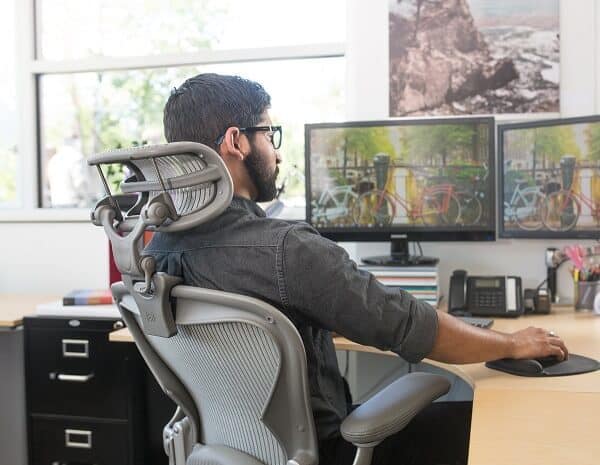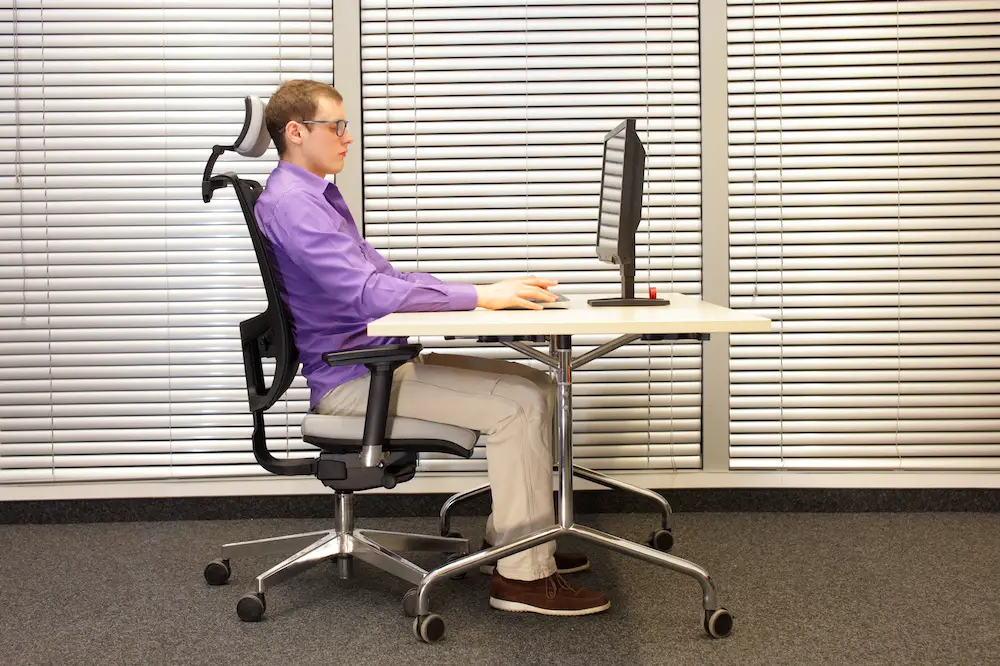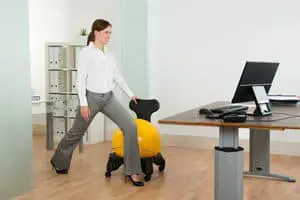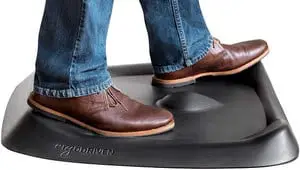Workplace or office workstation ergonomics isn’t unheard of, especially since many ergonomic products are already available today.
Regulatory agencies even encourage and suggest you include it in your annual budget.
It doesn’t matter if the budget is for meeting ergonomic equipment requirements or regularly conducting an ergonomic risk assessment.
Why is ergonomics important in the workplace?
It’s undervalued and overlooked by some company owners, operators, managers, supervisors, work-from-home professionals, and employees.
Read ahead to understand its long-term benefits clearly.
At Office Solution Pro, we are passionate about Ergonomics! Our readers support the page. If you click on a link, we may earn a small commission at no cost to you. We hope you love the products we recommend as much as we do!
Why Is Ergonomics Important in the Workplace?
The top reasons it’s essential to invest time, money, and effort in proper ergonomics are as follows:
1. Injury Prevention
An average person will spend one-third of their life at work, so developing an acute and chronic occupational injury and illness isn’t uncommon.
In terms of having poor ergonomics for an extended period, the most common ones are:
- Musculoskeletal disorders or MSDs
- Repetitive motion injuries or RMIs
- Repetitive stress injuries or RSIs
- Neck, shoulder, and back muscle pain
- Eye pain
With workplace ergonomics, you can prevent all these health concerns and more. How?
It doesn’t matter whether you’re sitting, standing, or bending.
When the body is in its neutral position or natural position, sufficient blood flow supplies all body parts with the right amount of oxygen.
In turn, there will be less swelling and physical strain, leading to one or more of the mentioned health issues.
2. Improved Productivity and Work Quality
We are all aware that fatigued workers and those who experience mental, emotional, and physical stress tend to be irritable and have poor focus.
Not only that, but long-term stress can lead to cognitive impairment and numerous health issues.
These issues can lead to lower productivity levels and decreased work output quality.
With the best ergonomic practices, you and your workers will have a productive workday.
As a result, you’ll end up having a comfortable workday.
3. Better Employee Engagement and Retention
A study found that 60% of individuals would take a low-paying job with better benefits over one with a higher salary offer but limited benefits.
Also, a 2015 survey concludes that 80% of employees prefer additional retirement and health benefits over a wage increase.
As such, employees who work in a company committed to safety and health are more engaged or involved and motivated in their daily job tasks.
They will also care more about the company.
They won’t just work for the sake of working or earning but will contribute to the company’s growth and tactics for achieving its objectives and goals.
There’s also less absenteeism and reduced resignation and turnover rates.
4. Cost Reduction
Poor ergonomics leading to injuries, sickness, and absenteeism come with direct and indirect costs.
Direct costs include claims due to prescription medicines, medical treatments, physician consultations, hospitalizations, and insurance premiums.
For indirect costs, some of the most common examples are:
- Modified duty accommodation
- Unsafe workplace or office environment investigations
- Legal duties when an injury is proven to be caused by an unsafe workplace
- Overtime pay of staff covering for the absent employee
- Job advertisement to replace an employee who doesn’t return to work
- New employee/s orientation and training
To give you a better perspective, let’s look at specific cost reductions of some companies that reduced or removed ergonomic hazards in their workplace.
These numbers are based on the data collected by the Washington State Department of Labor and Industries:
- Blue Cross & Blue Shield of Rhode Island: Saved over $200,000 in worker compensation expenses within a year
- Colby College: Over $100,00 savings every year
- Public Utility: Saved over four million dollars in a decade
- SOCHS Nursing Homes: 35% reduction in worker compensation expenses in three years
- VDT workstations: Saved $60,000 in employee’s medical expenses

How Can You Promote Ergonomics in the Workplace?
Now that you’re familiar with why ergonomics is important in the workplace, you’re likely interested in knowing how to start promoting and applying workplace ergonomics.
Here are some tips from the experts:
1. Conduct Thorough Ergonomics Assessments
A detailed assessment of the workspace and the specific risks each employee gets exposed to is the first step toward ensuring ergonomics in the workplace.
That’s especially since they have different roles to play.
For instance, employee A sits in front of the computer monitor for six to eight hours, while employee B mainly lifts heavy objects.
It’s also best to seek your employees’ opinions and suggestions regarding improved ergonomic practices and solutions.
After all, they’re the ones who will first notice and experience first-hand current workplace ergonomics hazards, distractions, and other issues.
This initial ergonomic assessment becomes the foundation for creating the most effective improvements in the workspace.
2. Purchase Safe Equipment
Consider the nature of your employee’s work and the comprehensive assessment results.
Purchase the right equipment for each department.
Provide your employees who sit for long periods of time with ergonomic desks and chairs. Depending on their size, employees might need high-back office chairs, mid-back, footrests, or other items to make up for being short or tall.
Those doing computing jobs, typing, and the like should also have ergonomic keyboards, mice, mouse pads, and computer monitors or display screen equipment.
Meanwhile, cushioned floor mats can help those who stand for hours, while knee pads are perfect for those who perform jobs involving kneeling.
They will help reduce or prevent pressure in the area. Investing in machinery and carts designed for lifting and moving heavy items will also greatly help.
Purchasing a stable and durable stool that employees can use. Offer a step stool to reach items on high shelves or cabinets also to ensure their comfort and safety.
The equipment you purchase for your employees should also allow them to shift comfortably from one position to another.
The good thing about most ergonomically designed products is that they have adjustable parts, backrests, armrests, height, and more.
You’ll even find tables that will allow you to shift from sitting to standing.
3. Improve Workspace Lighting
Not everyone knows that lighting is part of ergonomics. A well-lit workspace prevents headaches, eye fatigue, and accidents leading to injuries.
If your space doesn’t allow enough natural lighting to enter, consider installing more artificial lights.
Table lamps are also perfect for desk workers since they can adjust the amount of light in their workspace according to their specific needs.
4. Provide a Spacious Working Area
This doesn’t mean you have to renovate your current space or look for a larger one.
It simply means maximizing your available space without you and your staff feeling suffocated.
Make sure everyone can move around without bumping into each other, tables, chairs, cubicles, and other items.

5. Be Open to Rest and Relaxation Activities
Parties and team-building events are among many companies’ most common rest and relaxation activities.
Although they do work, remember that every day is different for every worker.
Thus, they must get a chance to rest and relax for better productivity and work quality, even for just a few minutes daily.
Simple things like allowing them to have short breaks, maybe to walk around to stretch their legs after sitting for hours, are enough.
Doing so will also help reduce repetitive movements that can lead to stress-related or overuse injuries.
Experts also suggest you spare a few minutes daily to perform ergonomic exercises and stretches together.
6. Involve Your Employees
Besides involving your employees during the assessment phase, ensure you educate and train them about ergonomics.
Posters and other internal communication materials are also advisable to remind them of ergonomics.
This way, not only will they have a complete understanding of the program, but they will also implement it subconsciously and consciously.
It will also be easier for employees to spot any risks so they can report them immediately to the person in charge.
A Healthier Workplace Through Ergonomics
Ergonomics in the workplace is undoubtedly important as it affects daily business practices.
It ensures a safer and healthier working environment for everyone, which will reflect in the products and services you offer.
Always aim to establish a workplace with a health and safety culture.
Be on the lookout for physical, mental, and emotional health problems to stimulate maximum productivity, reduce costs, and prevent daily hazards.
If all else fails, hiring a safety professional or having a designated trained safety representative would be a good idea.

Sources
- Mayo Foundation for Medical Education and Research.
- 2021 Gettysburg College. All rights reserved.
- Yuen, E. Y., Wei, J., Liu, W., Zhong, P., Li, X., & Yan, Z. (2012). Repeated Stress Causes Cognitive Impairment by Suppressing Glutamate Receptor Expression and Function in Prefrontal Cortex. Neuron, 73(5), 962. https://doi.org/10.1016/j.neuron.2011.12.033
- The 2016 Aflac WorkForces Report survey
- Glassdoor Team Career Advice Experts
- Puget Sound Human Factors and Ergonomics Society
- 1997-2022 Canadian Centre for Occupational Health & Safety







